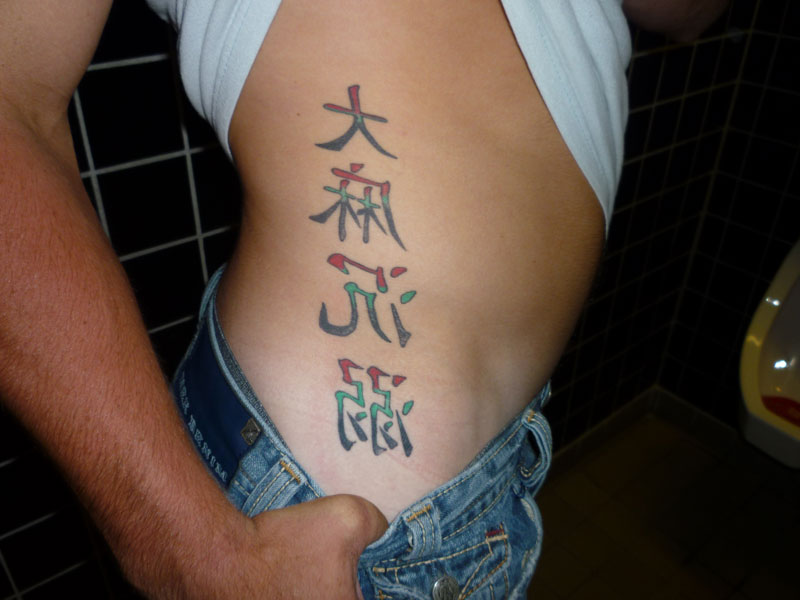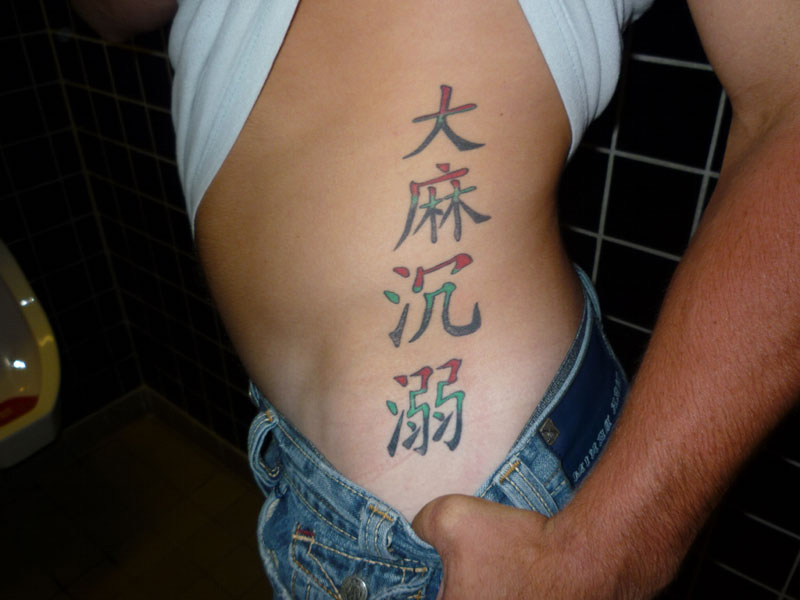Hooked on pot
« previous post | next post »
Carl Masthay sent me the following photograph of a tattoo consisting of four large Chinese characters:
Viewed thus, the characters are unreadable. When flipped as in a mirror, they look like this:
The characters are dàmá chénnì 大麻沉溺 ("addicted to marijuana").
Florian Simala astutely observes:
It looks like a button-down watch pocket on top of the right side pocket of the jeans is where it should be. The tag on the back reads correctly, "1 XG denim", so the tattoo must be backwards.
This means that the reversal of the tattoo is not due to inversion of the entire photograph but to the work of the tattooer. When flipped (as in the second photograph above), the writing on the pants is reversed.
The same thing (mirror reversal of characters) happened in this ad put out by the Massachusetts Office of Travel and Tourism: "Massachusetts is red(-faced)".
One more reason not to get a Chinese tattoo, especially not when you're high on your favorite addiction, and not unless you're 100% certain that the tattoo says something that won't embarrass you ten or twenty years from now. (Lots of negatives there, but I hope that the sentence still makes sense.)


Jim Breen said,
July 9, 2013 @ 9:26 pm
I see a lot of reversal/inversion of hanzi/kanji around. When Kurosawa's "Ran" came out it seemed every second poster or advertisement got the character (乱) in a wrong orientation.
Some years back a major Australian stockbroking company was having a promotional push into Hong Kong, and produced a glossy brochure/prospectus as part of it. The brochure came back from the printers with the 港 of 香港 upside down. (A Japanese-speaking friend of mine there noticed it in time.)
MrFnortner said,
July 10, 2013 @ 7:45 am
We could give the owner of this slogan some credit for a simple use of stenography. Properly placed, the slogan is provocative (to some), and reversed, it is impenetrable.
MrFnortner said,
July 10, 2013 @ 7:46 am
Steganography (coopertino)
Philip Lawton said,
July 10, 2013 @ 8:12 am
I think MrFnortner has it: sort of hiding your (illegal?) activities in plain sight.
Victor Mair said,
July 10, 2013 @ 8:34 am
Another colleague joins in:
=====
I've seen English script tattoos done backwards deliberately so as to hide what it actually says. But here in the US, there would be no reason to do this because 99% of Americans can't read the Chinese characters. If this guy is in the US, I think the tattoo artist just screwed up. I wonder if the guy knows?
Shan Huang said,
July 10, 2013 @ 8:47 am
I'd say the first two characters and the last two should switch their places. The drug 大麻 here is the object in the sentence. So 沉溺大麻 sounds better. However, 沉溺于大麻 is what most educated people would use. 于(yu, 2nd tone) functions as a preposition here. It's sort of like the "in" in the phrase "indulge in something".
Jim already pointed out the reversed hanzi. But it's still a cool tattoo:-)
Mark P said,
July 10, 2013 @ 9:20 am
It looks like something that would happen if the person with the tattoo had actually done the work himself while looking in a mirror.
Brian said,
July 10, 2013 @ 9:48 am
Or the tattooer simply forgot to reverse the letters when creating the initial stencil.
Victor Mair said,
July 10, 2013 @ 10:01 am
@Shan Huang
The whole point of this post was about the reversed hanzi.
Thanks for your grammatical observation. I'll be waiting for others to join in on that aspect.
julie lee said,
July 10, 2013 @ 10:46 am
If this was a photo developed from a negative, the reversed characters could also be due to the photo negative flipped the wrong way. The person who developed and/or disseminated the photo probably couldn't read Chinese.
Victor Mair said,
July 10, 2013 @ 11:02 am
From a friend in China:
=====
I don't think the places of the characters should be switched. Although “沉溺" is usually used as a verb, here it can be seen as a noun, meaning addiction. Therefore, "大麻沉溺" can be explained as "对大麻的沉溺" (addiction to marijuana). There are many similar phrases, such as: 军事迷、技术控 and so forth.
=====
Nathan Myers said,
July 10, 2013 @ 2:40 pm
It's common (at least in my circle) to be able to read English
text upside-down, backwards, and worse at near full speed,
after a few minutes' ramp-up. I get the impression from the
above that this is rare for Mandarin. Is it more difficult than
for English?
Samuel Wade said,
July 10, 2013 @ 2:42 pm
I'm feeling charitable. Might the reversal deliberately mean something like "whoa, I'm so addicted to the weed that I'm, like, totally flipped"?
Victor Mair said,
July 10, 2013 @ 3:36 pm
@Nathan Myers
In my original post, I stated that the reversed characters in the tattoo are "unreadable". That's not quite true, since I could read them almost immediately and with very little effort, because they are large, exceptionally clear, very well written, and perfectly proportioned in a standard form. For a neophyte, however, it would be very difficult to interpret them. I think that the greater complexity of the Chinese script makes it harder to comprehend when parts are reversed, moved around, or omitted, because much depends on the integrity and proper structural interrelationships of the components of the whole characters (a single missing or misplaced stroke can completely alter the meaning of a character). Conversely, linear, alphabetical writing consisting of only a small number (26) of simple, repeated symbols occurring in highly predictable circumstances makes it easier to understand even when reversed, turned upside-down, or otherwise altered than when the same operations are performed on Chinese writing.
Milan said,
July 10, 2013 @ 4:18 pm
I wonder whether the guy knows what his tattoo says. Both alternatives, him being and him not being aware of the meaning seem quite plausible to me. Either the guy wanted have his love for marihuana inscribed in his body, but not in a too blatant fashion, or some tattooer played a prank on a guy walking in his studio, being stoned and wanting "something Chinese, no matter what". I guess such a demand would be quite offensive to a tattoo artist of Chinese origin — exactly the kind of person who would be able to do this thing.
Victor Mair said,
July 10, 2013 @ 9:01 pm
From Melvin Lee:
I basically agree with Shan Huang. When 沉溺 is used as a verb, there should be followed by a 于, "沉溺于大麻" is equivalent to "addicted to marijuana" in English.
However, when I saw the tattoo "大麻沉溺", I immediately thought of another phrase "性沉溺" (sex addiction), which is not an uncommon term to Chinese native speakers. In that phrase 沉溺 is used as a noun. Since it is a symptom of behavioral health issues, sometimes people will add "症" after it. Actually, there is another similar phrase "网络沉溺症" (Internet addiction) which is also a common term.
Victor Mair said,
July 11, 2013 @ 3:44 am
From David Moser, who tried to post this himself, but was unsuccessful, probably because he tried to attach photographs:
=======
These characters look a little bit like a kind of calligraphy invented by street performers and xiangsheng artists in the late Qing and early 20th century. They call the form 白沙撒子, and there are references to it. Here's a pretty good video demonstration of the form:
http://www.youtube.com/watch?v=_09VZDyageg
especially around 8:10.
And a YouTube of Hou Baolin demonstrating it.
http://www.youtube.com/watch?v=3GiYA1QuMyU
And a few references. I've attached some photos that are also examples. I'll reply to this on LL also.
http://www.china5080.com/articles/8188.html
http://www.360doc.com/content/11/1017/08/3218641_156777838.shtml
https://zh.wikipedia.org/wiki/%E7%99%BD%E6%B2%99%E6%92%92%E5%AD%97
Jason Cullen said,
July 11, 2013 @ 2:31 pm
When I was teaching at Purdue, the secretary of our department and I were buddies and we'd hit what passed for a scene in northern Indiana. She knew I could read Chinese, and inevitably we would run into dozens and dozens of people with Chinese tattoos. She loved it when I'd translate them and the person would express in horror, "NO NO, it's supposed to say 'loves Jesus'" or something. But what really impressed me was how often the tattoo was backwards, like this photo. I don't think I'd be exaggerating to say about half of them were. So, as Dr. Mair said, ANOTHER reason not to get a Chinese tattoo (unless, of course, approved and signed in triplicate by a quorum of 20 Chinese, and stamped by Dr. Victor Mair). ;-)
Victor Mair said,
July 11, 2013 @ 8:20 pm
from Jing Wen:
I think 沉溺 plus object is also right. 他沉溺于大麻 = 他沉溺大麻, 沉溺美色 = 沉溺于美色.
But 大麻沉溺 sounds odd. Maybe this tattoo wants to say 大麻沉溺者(沉溺于大麻的人).
J.Xiao said,
July 14, 2013 @ 10:44 am
That might be partly personal preference, and I did recognize some forms of addictions did get translated as '-沉溺'. But I think 沉溺 is more general and can refer to any kind of wallowing and indulgence. In contrast, 癮 (yǐn) or 成癮 (chéng yǐn, more formal and referring to process of getting addicted) is more specific to addiction due to overuse of chemicals. So 大麻癮 may be the word he's looking for. If he wants to label himself as a marijuana addict however, 大麻癮君子 (yǐn jūnzǐ, lit. chain-smoker, drug addict) may be appropriate (for him of course, yǐn jūnzǐ is a derogatory term after all.)
ASG said,
August 7, 2013 @ 3:47 pm
I doubt very much that the tattoo is a joke or a prank played on the client. The colours of the tattoo (red, green, and black) are strongly associated with Rastafarianism and thus, by extension, marijuana. Do a Google image search on the word "rasta" and almost every picture you see will be in these "pan-African" colours. I assume that this man wanted to signal his addiction visually even to people who can't read Chinese.
Victor Mair said,
August 29, 2013 @ 5:26 pm
From Geok Hoon (Janet( Williams:
I wonder if the tattooer is left-handed. If so, it is likely that the mirror image makes sense to him naturally.
The font is in beautiful Kai. Of course it's more likely that the tattooer placed his stencil the wrong way round.
Any advanced learner could read the characters easily as we are already programmed to recognise the shapes of the characters. Therefore, reversed hanzi is possible for communication.
I'm always been curious about dyslexia with character recognition. Please let me know if you think there could be a link.